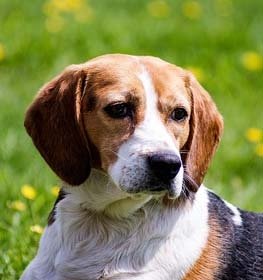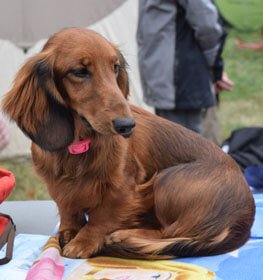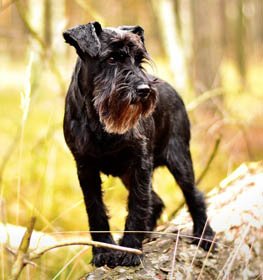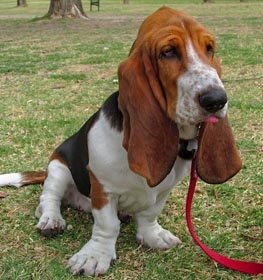Basenji Information & Dog Breed Facts
Collection of all the general dog breed info about Basenji so you can get to know the breed more.
| Group | Hunting Dogs |
|---|---|
| Popularity Rank | 84 |
| Reviews | 2 |
| User Ratings | |
|
Compare the Basenji With Other Dogs
Select at least one dog breed to make the comparsion. | |
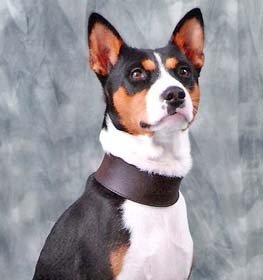 | |
| Origin | |
|
Common Names & Aliases
What other names is a Basenji known by? Discover all traditional, regional and informal names used for this breed. | African Barkless DogAfrican Bush DogAngo AngariCongo TerrierZande DogCongo Dog |
|---|---|
|
Breed Classification
What type of dog breed is a Basenji? Learn about its genetic classification and breeding category. | Purebred |
|
Size Classification
What size category is a Basenji? Learn how big the Basenji breed typically grows. | Medium |
|---|---|
|
Weight Statistics
How much does a Basenji weigh? Discover typical weight ranges for adult males and females of the Basenji breed. | Male: 22-26 pounds (10-12 kg), Female: 20-25 pounds (9-11 kg) |
|
Average Weight
What is the average weight of a Basenji? | Male: 24 pounds (11 kg), Female: 22.5 pounds (10 kg) |
|
Height
How tall is the Basenji? Basenji height: | Male: 16-17 inches (41-43 cm), Female: 15-16 inches (38-41 cm) |
|
Average Height
What is the average height of a Basenji? | Male: 16.5 inches (42 cm), Female: 15.5 inches (39.5 cm) |
|
Price Range
How much does a Basenji puppy cost? Find current market prices and factors affecting Basenji costs. | $1000-$1200 If you choose to purchase the Basenji, you should know that the mentioned amount of money is an average of the collected data from breeders’ sites and puppy finder places. If you have a Basenji for sale, please advertise it on a reliable website to make sure the Basenji gets to a happy place. |
|---|---|
|
Availability
How easy is it to get a Basenji? How many Basenji are there in the world? | Very frequent: The Basenji is quite easy to get. There is a risk of overbreeding, as it is an extremely popular breed. Inbreeding is common because of its popularity. A new study suggests that inbreeding contributes to the incidence of disease and health problems. So be careful, buy from a trustworthy place or kennel and seek the help of an experienced person, a professional, to make the right decision. |
|
Intelligence Rating
How intelligent is a Basenji? Discover the Basenji's intelligence ranking and learning capabilities. | Low: The Basenji is one of the dog breeds that have the lowest degree of obedience intelligence. You need to work hard if you want to impress people with these dog tricks and commands. They understand and memorize new commands in 80-100 repetitions, and obey the first command 25% of the time or better. |
|---|---|
|
Training Difficulty
How easy is it to train a Basenji? Learn about the Basenji's trainability and response to training methods. | Basenji dogs are easy to train. They find out the association between commands and actions quite quickly. |
|
Watchdog Rating
How good is a Basenji as a watchdog? Learn about the Basenji's alertness and guarding instincts. | Basenji dogs are one of the best watchdogs. Their main job is to observe and they're very consistent in their effort. The best vocal cords and sense of hearing belong to them. Usually, they're very territorial and protective about their property, so the Basenji dogs will alert you if they sense something different. |
|
Territorial Protection
Is a Basenji protective of its territory? Learn about the Basenji's guarding instincts and behavior. | Basenji dogs are average defenders. Some dogs are very protective of their territory, while others easily let a stranger to trespass. This breed is not sure to defend its territory in every situation. |
|
Personality Traits
What personality does a Basenji have? Learn about characteristic Basenji temperament and behavior traits. | CuriousPlayfulEnergeticAlertIntelligentAffectionate |
|---|---|
|
Sensitivity Level
How sensitive are they? Basenji sensitivity: | Basenji dogs have an average emotional level and are not the most sensitive dog breed. Sometimes it's okay to change the daily routine, have guests and listen to loud music.
Some dogs handle moderate punishment very well, while others crumble apart at a dirty look. This breed is not affected emotionally by moderate punishment. |
|
Affection Level
How affectionate are they? Is a Basenji a good family dog? | Slightly Below Average: Basenji dogs may seem unfriendly sometimes due to their independence. Their happiness doesn't depend on their owner's emotional level. |
|
Social Needs
How much social interaction does the African Barkless Dog need? Basenji social needs: | Basenji dogs are kinda antisocial. This breed doesn't like being around people all the time, they tolerate being left alone. |
|
Impulse to Wander or Roam
How likely is the Basenji to run away? Does this breed explore or wander a lot? Does Basenji roam? | Basenji dogs have high wanderlust potential, which means that this breed has a strong desire for exploring the world. Safer to walk them on a leash unless you teach them how to get back to you on command. This breed is also able to cause damage to your fence. |
|
Prey Drive
Do this canine have a strong prey drive? Does Basenji have high prey drive? | Basenji dogs have a high impulse to chase and catch something. Cats or any other small animals are in danger. It's a natural instinct, doesn't necessarily mean that Basenji dogs are aggressive. Better to keep this breed on a leash. |
|
Barking Frequency
Does a Basenji bark a lot? Learn about typical Basenji vocalization patterns and triggers. | Low: The Basenji barks none to minimal. Perfect choice if you prefer a quiet breed.
Top reasons for barking: protection, alarm, fear, boredom, attention-seeking, greeting, separation anxiety, compulsive barking. |
|---|---|
|
Playful Nature
How playful is a Basenji? Understand the typical play drive and energy level of the Basenji breed. | Average: Basenjis, like any other dog breed, like playing. Sometimes they bark in excitement for playing, but they are not the most playful dog breed. |
|
Apartment Adaptability
Can a Basenji live in an apartment? Learn about the Basenji's suitability for apartment living. | It is not recommended to keep the Basenji breed in the home. It does best in the garden, but if you do want to keep it indoors, it should be exercised thoroughly with long daily walks, so you can keep the Basenji indoors by introducing daily routines. |
|
Lifestyle Adaptability
How adaptable is a Basenji to lifestyle changes? Learn about the Basenji's flexibility to new situations. | Average: Basenji dogs adapt to lifestyle changes and different living environments quite okay usually. |
|---|---|
|
Alone Time Tolerance
Can a Basenji be left alone? Learn about the Basenji's tolerance to solitude. | Basenji dogs handle alone time quite well. They are not prone to have separation anxiety. |
|
Bite Risk Assessment
What is a Basenji biting potential? Learn about the Basenji's bite risk factors. | Low 🔽 The Basenji has a low chance of biting somebody. Top reasons for dog bite: protection, pain, excitement, herding instinct, being provoked. (Data based on the available online bite statistics.) |
|---|---|
|
Mouthing Tendency
Is a Basenji mouthy? Learn about the Basenji's tendency to use mouth during play. | Basenji dogs have a strong tendency to nip, chew, play-bite, or herd people. It's a common habit during puppyhood, not aggressive behavior. These "bites" don't hurt, but Basenji dogs need to be taught a good attitude.
We have compiled a list of Mouthy Dog Breeds. |
|
Bite Strength Rating
How strong is a Basenji bite? Learn about the Basenji's bite force measured in PSI. | Between 200 and 400 PSI ⏺ Basenji bite force: Ordinary. Bite force Basenji measurements typically fall within the range of 200 to 400 PSI. The bite force of a Basenji is considered ordinary when compared to other dog breeds, but it is still quite powerful. This Basenji bite force PSI can cause bite wounds. Basenji bite PSI is not something that should be feared if the dog is well-trained and managed. To avoid any issues, it's essential to learn how to train a Basenji puppy not to bite from an early age.
The Basenji, and many others, have a fearsome presence because they have significant jaw strength, so it is important not to anger the dog and have it around strangers until it is fully trained. However, they are usually quite calm and good companions, they work well in families and are easy to care for. In conclusion, while the Basenji bite force is certainly an interesting aspect of the breed, it is important not to let it overshadow the many other reasons why these dogs are so loved and respected. With proper training and socialization, a Basenji can be a loyal and protective companion for your family. |
|
Average Lifespan
How long does a Basenji live? Learn about the typical lifespan of the Basenji breed. | 10-12 years The average lifespan of Basenji: 11 years |
|---|---|
|
Climate Tolerance
How well does a Basenji handle different weather? Learn about the Basenji's climate adaptability. | Prefers warm weather Dogs that prefer warm weather conditions are typically breeds that were originally bred in warmer climates. |
|
Health Concerns
What health issues are common in a Basenji? Discover typical conditions affecting the Basenji breed. | The Basenji is a healthy breed, but there are certain health issues that you should check with your vet regularly. |
|
Vet Care Frequency
How often does a Basenji need vet visits? Learn about the Basenji's veterinary care requirements. | Average The Basenji should have a complete physical check-up at least once per year. If your dog shows any symptoms, call your veterinarian. |
|
Health Problems
What genetic/health problems does the Basenji breed have? What are the health issues and concerns of the Basenji breed? Most common health risks of Basenji: | Eye ProblemsProgressive retinal atrophy (PRA)Kidney Issues |
|
Energy Rating
How energetic is a Basenji? Understand daily activity needs of the Basenji breed. | Basenji dogs are high-energy dogs. An active lifestyle makes them happy. |
|---|---|
|
Activity Requirement / Exercise Need
How much exercise does a Basenji need? How much exercise do Basenji dogs require per day?
Do Basenji dogs need a lot of exercises? | Basenji dogs need quite a lot of exercise. Daily walks should be on schedule. If you live an active life, this breed can be a good choice for you. |
|
Sleeping Need
How much sleep does the Basenji breed need? | Basenji dogs don't need too much sleep. They are energetic and desire to live active life. If you think naps are overrated, this breed can be the best choice for you. |
|
Obesity Tendency
Is a Basenji prone to weight gain? Learn about the Basenji's obesity risks. | Low to Average: The Basenji has a low to the average risk for obesity. To make your dog happy and fit, feed him with quality dry dog food and live an active life together. Try to find the happy medium between exercise and feeding.
If you notice any weight gain, consult your veterinarian and make a diet plan. Reduce unhealthy food and snacks, and measure the Basenji weight regularly. |
|---|---|
|
Food Consumption
How much food does a Basenji need daily? Learn about the Basenji's feeding requirements. | 3/4 to 1 cup of high-quality dry food a day, divided into two meals. |
|
Allergy Friendliness
Is a Basenji hypoallergenic? Learn about the Basenji's suitability for allergy sufferers. | No Basenji dogs don't do well with allergy sufferers by causing allergic reactions. Some dog breeds are even considered to higher possibility of an allergic response. Coat type isn't necessarily relevant, because most people are allergic to dander (flakes on the dog's skin) or saliva, not actually to dog hair. |
|---|---|
|
Coat Colors
What colors does a Basenji come in? Discover all possible Basenji color variations. | BlackTan Red White Brindle |
|
Grooming Requirements
How much grooming does a Basenji need? Learn about Basenji coat maintenance requirements. | Effortless: The Basenji requires minimal grooming. Seasonal flea treatment is needed, but cutting the dog's hair by a professional groomer isn't necessary. Ears and eyes should be cleaned sometimes to avoid infections. Basenji is one of the best choices if you don't have the time, skill, or money to take care of a high-maintenance dog. Highly recommended for beginners. |
|
Drooling Tendency
Does a Basenji drool a lot? Learn about the Basenji's drooling habits. | The Basenji is a perfect example of a low drooling tendency. If you dislike being covered by slobber spots on your clothes, the Basenji could be a good choice for you. Drooling is the unintentional saliva flowing outside of the mouth. It can be completely normal or a sign of a health problem. Certain dog breeds drool less than others, just like the Basenji.
If you notice any change in your dog's drooling habit, you should contact a vet as soon as possible. |
|
Stinkiness Rating
Does a Basenji smell bad? Learn about the Basenji's natural odor levels. | Low 🔽 The Basenji has a low chance of bad smell. Top reasons for dog stinkiness: infection of bad tooth/ear/skin folds, gas attacks. |
|
Coat Characteristics
What type of coat does a Basenji have? Learn about the Basenji's fur characteristics. | Fine |
|
Bathing Needs
How often does a Basenji need baths? Learn about the Basenji's bathing requirements. | 3-4 weeks More often than average. These dog coats tend to be longer, softer, and oilier than short-haired breeds. While a good bath every now and then is a great way to keep your buddy from becoming overly smelly, be mindful about overbathing.
Bathing will wash away your dog’s natural oils, while a simple brushing every few days should keep them clean. |
|
Shedding Level
How much do Basenji dogs shed? How to control, reduce and prevent the shedding of the African Barkless Dog? Do Basenji dogs shed a lot? | Basenji dogs shed none to minimal. Having a puppy from this breed you don't have to be afraid of your couch or car being covered by dog hair. Basenji dogs could be the best choice if you don't tolerate dog hair. |
|
Child Compatibility
Is a Basenji good with children? Learn about the Basenji's behavior around kids of different ages. | Basenji dogs are kid-friendly dogs. This breed is a good choice if you have children. |
|---|---|
|
Pet Compatibility
How well does a Basenji get along with other pets? Discover the Basenji's compatibility with other animals. | Basenji dogs usually don’t get on well with other pets. |
|
Stranger Friendly
Are they aggressive or friendly towards/with strangers? Basenji temperament with other people: | Basenji dogs are not the most stranger-friendly dogs. |
|
Cat Friendly
How well do Basenji dogs get along with cats? Are they good with kittens? What is this fido's temperament with cats? Can they be good with cats? Can the Basenji breed live with a cat? | Basenji dogs are not the most cat-friendly dogs. |
|
Dog Friendly
Is Basenji good with other dogs? Are they dog-friendly dogs? How well do Basenji dogs get along with other dogs? | Basenji dogs are not the most dog-friendly dogs. If you want more dogs in your family or you'd like to join dog meetups, the Basenji is not a good choice. |
|
Good For First Time Owners
Is Basenji breed good for first-time owners? Do they make a good dog for novice owners? Is Basenji breed suitable for first-time owners? | Yes Basenji dogs are good for novice owners, due to their easy-going personality. |
|
Office Friendly
Are Basenji dogs good office canines? Do Basenji dogs make good office-friendly pets? Can they be office dogs? | No Basenji is not the best dog breed for office environment. |
|
Senior Citizens Friendly
Are they senior citizens friendly dogs? How well do Basenji dogs get along with the elderly people? What is the African Barkless Dog temperament with senior people? Are Basenji dogs good for elderly owners? | Basenjis are usually recommended for elderly people. |
|
Service Dog Capability
Can a Basenji be a service dog? Learn about the Basenji's service work potential. | Not really This breed generally not used as a service dog. A service dog is a term used in the USA to refer to any type of assistance dog specifically trained to help people who have disabilities, such as visual impairment, hearing impairments, mental disorders, seizures, mobility impairment, and diabetes. Service dogs are protected under the ADA (Americans with Disabilities Act).
Basenji is not the best breed for service purposes. |
|---|---|
|
Therapy Work Suitability
Is a Basenji good as a therapy dog? Learn about the Basenji's therapy work aptitude. | Not really This breed is generally not used as a therapy dog. A therapy dog is a dog that might be trained to provide affection, comfort, and love to people in hospitals, retirement homes, nursing homes, schools, hospices, disaster areas, and people with anxiety disorders or autism.
Basenji is not the best breed for therapeutic purposes. |
|
Scent Detection Ability
Is a Basenji good at detection work? Learn about the Basenji's scenting abilities. | Not really They are not typically employed for this type of work, but there may be exceptional cases. A detection dog or sniffer dog is a dog that is trained to use its senses (mostly its smell) to detect substances such as explosives, illegal drugs, wildlife scat, currency, blood, and contraband electronics such as illicit mobile phones.
Basenji is not the best breed for detection purposes. |
|
Search & Rescue Potential
Can a Basenji do search and rescue? Learn about the Basenji's SAR capabilities. | Not really This dog breed is not typically used as a search and rescue dog. The use of dogs in search and rescue (SAR) is a valuable component in wilderness tracking, natural disasters, mass casualty events, and locating missing people.
The Basenji is not the best breed for SAR purposes. |
|
Maritime Work Ability
Is a Basenji good on boats? Learn about the Basenji's maritime capabilities. | Not really Basenji breed usually doesn't like being on a boat. Boat dogs were typically bred for their strength, stamina, and water resistance, as they were often required to perform tasks such as pulling in fishing nets, and jumping into the water to retrieve ropes or lines, or helping to move cargo. Sailor dog is a type of dog that was bred to accompany sailors on their voyages. They were typically used for three purposes: as a working dog, a watchdog, and as a companion. A boat dog is a term used to describe a type of dog that was traditionally bred and used as a working dog on boats. |
|
Draft Work Capability
Can a Basenji pull carts? Learn about the Basenji's drafting abilities. | Not really A drafting dog or draft dog is a dog bred and used for cart pulling. Dogs bred for this work have strong builds and qualities that are needed, strength and determination.
Basenji is not the best breed for drafting purposes. |
|
Military Service Background
Was a Basenji used in military service? Learn about the Basenji's military history. | Yes In history, this breed was unfortunately used for combat dogs. A combat dog is a specially trained dog that is used in warfare to help protect military personnel and assets. Combat dogs are often deployed in areas where there is potential for contact with the enemy, such as during raids or search operations.
Combat dogs are typically assigned to either infantry or special operations units. They are used for a variety of tasks including area security, sentry duty, trackers, and explosive detection. In addition to their combat roles, combat dogs also play an important role in troop morale by providing companionship and emotional support. |
|
Puppy Litter Size
How many puppies does a Basenji usually have? Learn about typical litter sizes. | 4-5 puppies |
|---|---|
|
Pregnancy Duration
How long is a Basenji pregnant? Learn about the Basenji's gestation period. | 60-64 days Reproductive cycle of the female Basenji: The first period called Proestrus lasts for about 9 days.
During this time the females start to attract males. You can notice by swelling vulva and bloody discharge. The second part is the Estrus when the female is receptive for the male. It lasts for about 3 to 11 days. The sign of the proestrus part is the soft and enlarged vulva. The discharge decreases and lightens in color. The third part is the Diestrus. Normally, it occurs around day 14. In this period the female’s discharge changes for vivid red and coming to its end. The vulva returns to average, and she will no longer permit mating. The fourth part called the Anestrus. The time frame between heat periods normally lasts about six months. |
|
Breeding Frequency
How often can a Basenji have puppies? Learn about safe breeding intervals. | Once a year. More frequent breeding is not healthy. It is very important not to buy a dog from a puppy mill, where the needs of the pups and their mothers are ignored. It's an inhumane high-volume dog breeding facility, where puppies born several times a year. |
|
AKC Classification
What AKC group is a Basenji in? Learn about the Basenji's AKC classification. | Recognized by the American Kennel Club in 1944 as a Hound breed. |
|---|---|
|
FCI Classification
What FCI group is a Basenji in? Learn about the Basenji's international classification. | Recognized by FCI in the Spitz and primitive types group, in the Primitive type section. |
|
Kennel Club Recognition
Which kennel clubs recognize a Basenji? Learn about the Basenji's official recognition. | Canadian Kennel ClubDog Registry of America Inc.Kennel Club of Great BritainNorth American Purebred Registry, Inc.American Canine Association, Inc.Australian National Kennel CouncilContinental Kennel ClubNational Kennel ClubNew Zealand Kennel ClubUnited Kennel ClubCanadian Canine RegistryAmerican Pet Registry, Inc. |
Basenji Pros and Cons
- Training Difficulty: Basenji dogs are easy to train.
- Grooming Requirements: Effortless: The Basenji requires minimal grooming.
- Shedding Level: Basenji dogs shed none to minimal.
- Drooling Tendency: The Basenji is a perfect example of a low drooling tendency.
- Stinkiness Rating: The Basenji has a low chance of bad smell.
- Obesity Tendency: Low to Average: The Basenji has a low to the average risk for obesity.
- Watchdog Rating: Basenji dogs are one of the best watchdogs.
- Alone Time Tolerance: Basenji dogs handle alone time quite well.
- Child Compatibility: Basenji dogs are kid-friendly dogs.
- Senior Citizens Friendly: Basenjis are usually recommended for elderly people.
- Good For First Time Owners: Basenji dogs are good for novice owners, due to their easy-going personality.
- Intelligence Rating: Low: The Basenji is one of the dog breeds that have the lowest degree of obedience intelligence.
- Allergy Friendliness: Basenji dogs don't do well with allergy sufferers by causing allergic reactions.
- Apartment Adaptability: It is not recommended to keep the Basenji breed in the home.
- Mouthing Tendency: Basenji dogs have a strong tendency to nip, chew, play-bite, or herd people.
- Impulse to Wander or Roam: Basenji dogs have high wanderlust potential, which means that this breed has a strong desire for exploring the world.
- Cat Friendly: Basenji dogs are not the most cat-friendly dogs.
- Dog Friendly: Basenji dogs are not the most dog-friendly dogs.
- Office Friendly: Basenji is not the best dog breed for office environment.
Basenji History
Introduction
Scientific research has officially confirmed what Basenji enthusiasts have long suspected, Basenjis are one of the oldest breeds of dogs on this earth.
They are regarded as the most attractive and intelligent of all breeds by their admirers. The Basenji captures its owner’s affection whether it’s hunting, proudly posing in the sun, or receiving hugs.
Origins and early history
Drawings of pariah-type dogs can be found in various hunting scenarios in prehistoric cave paintings discovered in Libya between 6000 BC and 100 AD.
The Egyptians had Basenjis as shown by relics from as early as 3000 BC. Their curled tails and prick ears are clear and they appear to be wearing the typical hunting bells still used in Africa. Moreover, Dr. Schweinfurth traveled to Africa around 1868 and wrote about domestic animals.
Among the different dogs, he found and illustrated that there is one which is surely the Basenji. He found the dogs that were clearly Basenjis among people who were hunters rather than pastoralists.
According to explorers and authors, Basenjis were found many times with the Pygmies. Pygmy peoples are ethnic groups whose average height is unusually short.
Moreover, this breed had survived in Africa for millenniums as they were excellent hunting dogs and provided their owners with a good amount of food.
The Basenji produced an unusual yodel-like sound, due to its unusually shaped larynx. This trait also gave the Basenji the nickname: ‘Barkless dog’.
Name
In the native Lingala language, the Azande and Mangbetu people of the northeastern Congo region refer to Basenjis as “mbwá na basnzi”.
This translates to "dogs of the savages" or "dogs of the villagers." The Basenji is also known as the "dog of the bush" in the Congo.
“M'bwa m'kube,'mbwa wa mwitu'” (Wild dog), or “dog that jumps up and down,” is another local term, referring to their inclination to jump straight up to spot their prey.
Basenjis migrate from Africa
The first Basenji-like dogs that made it from Africa to Europe were seen in the 1880s. They were first called Congo Terriers and a standard was created.
However, they were somewhat different in look from the traditional ideal Basenji. The first dogs to be exhibited appeared at Crufts in 1895 and were called African Bush Dogs or Congo Terriers.
Several attempts were made to bring the breed to England, but the earliest imports succumbed to the disease.
In 1923, for example, Lady Helen Nutting brought six Basenjis with her from Sudan, but all six died from distemper shots they received in quarantine.
It was not until the 1930s that foundation stock was successfully established when finally in 1936 Mrs. Olivia Burns successfully imported Basenjis to England and started breeding them.
Moreover, additional imports from Africa to England began between 1938 and 1939 before the war years interrupted the breed’s development.
It was Miss Veronica Tudor-Williams who made heroic efforts to keep the breed alive in England during the difficult times.
Basenjis in America
Basenji fanciers in the US and Canada leaped into the breed with enthusiasm from the earliest opportunity. Two of the first Basenjis were called Bakuma and Blean in 1937.
Interestingly Bakuma somehow came into the possession of early fanciers Mr. and Mrs. Al Phemister who renamed him Phemister’s Bois.
Bois became very significant in early breeding in America as he was the father of the first American Kennel Club champion. In 1941, they saw the importation of dogs directly from Africa to the United States by animal importer Henry Trefflich.
It is likely that nearly all the Basenjis in the Western world are descended from the few original imports. Moreover, the breed was officially accepted into the AKC in 1943, and in the year 1951 151, Basenjis were registered at the kennel club.
The popular movie “Goodbye, My Lady” gave a boost to the breed’s popularity and by 1957 the numbers were up to 651. In 1990 the AKC studbook was reopened to 14 new imports at the request of the Basenji Club of America.
It was believed at that time that those dogs would be the final imports. However, in 2008, the Basenji Club of America petitioned again and the studbook was open for an additional five-year period.
In 2009, 10 additional dogs, imported from Africa, were registered. Unfortunately, according to the AKC, the popularity of the Basenji in the United States has declined over the past decade, with the breed ranking 71st in 1999, decreasing to 84th in 2006, and to 93rd in 2011.
Latest Basenji Compares
Basenji Names
How old is my Basenji in human years?
You May Also Like
Rate The Basenji Breed
Basenji Comments, Reviews and Questions
- Stephan Ebol
Jul 26, 2021, 9:07:24 PM:
Basenji IS an hypoallergenic dog. It is precisely the reason why i could adopt one, following the advice of my veterinarian.
- Khloe Towler
Nov 19, 2020, 5:49:23 PM:

